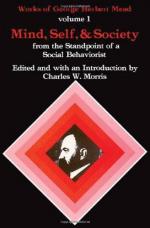|
This section contains 8,385 words (approx. 28 pages at 300 words per page) |

|
SOURCE: "George Herbert Mead and the Paradox of Prediction," in Sociological Analysis, Vol. 38, No. 2, Summer, 1977, pp. 91-105.
In the following essay, Nye discusses the more obscure ideas of Mead's philosophy, and places them in context with Mead's better known work.
It has been stated and reiterated that George Herbert Mead has become the captive of his interpreters (Natanson, 1956:2; Douglas, 1970:17). The purpose of this essay is to initiate a metaphorical liberation of Mead from his social psychological captivity. However, this is not another attempt to unearth what Mead "really meant" when he speaks of the social self, the "I," the "me," the "generalized other" or the like. This has already been done repeatedly with the net result of establishing two schools of interpreters, the determinists and the non-determinists (Kuhn, 1964; Abbott, et al., 1973; Singlemann, 1973). I wish instead to employ an approach which attempts to understand Mead's "social psychology" in the...
|
This section contains 8,385 words (approx. 28 pages at 300 words per page) |

|


